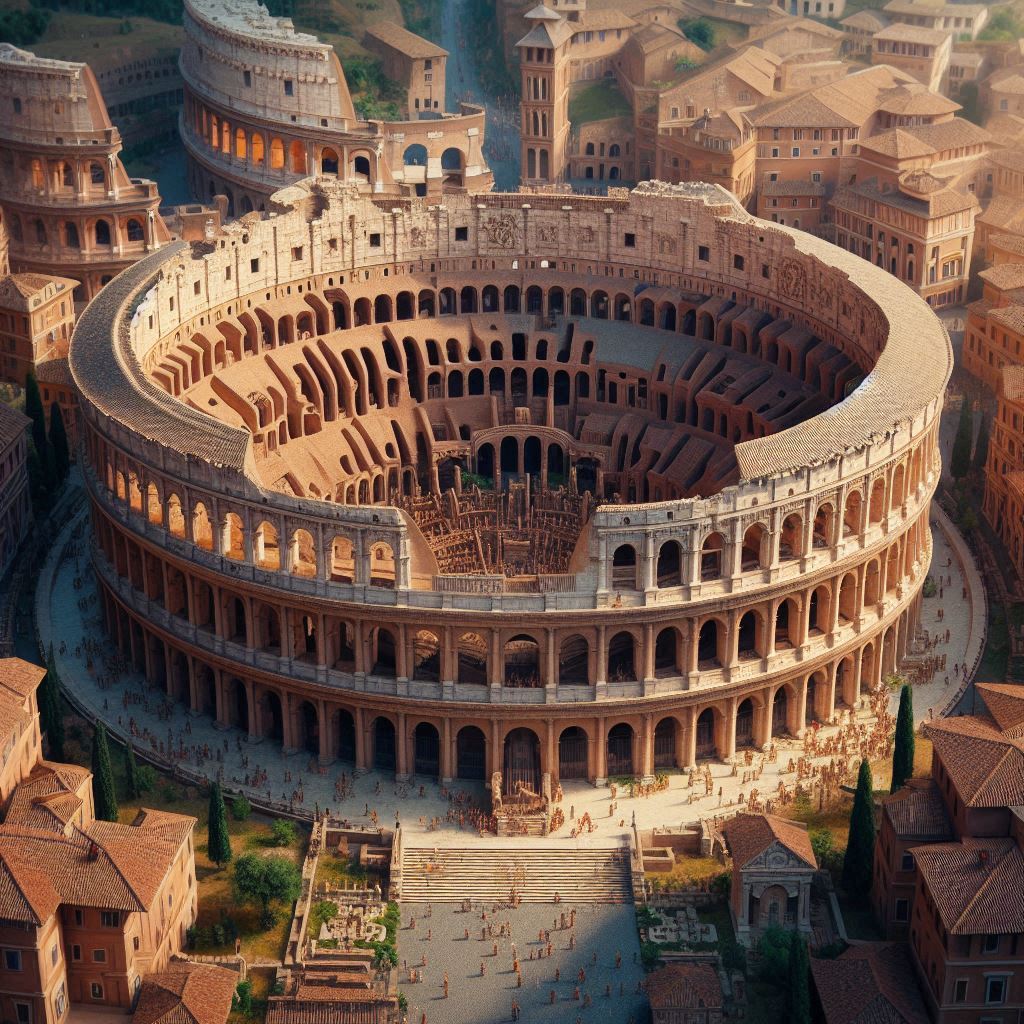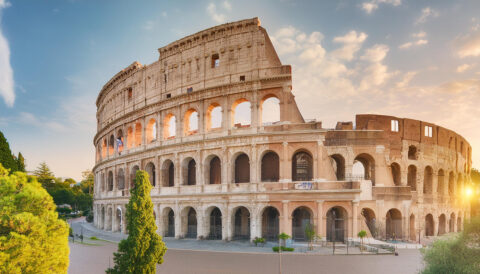Rome was founded in 753 BC, by the two brothers Romulus and Remus.
According to ancient history timeline, the Roman Empire was founded in 27 BC and ended in AD 476. During the Classical Era, the Roman Empire dominated the larger part of Mediterranean region. The Roman Empire grew over several centuries to encompass all of the Mediterranean region before collapsing. However, up until the fall of the Roman Empire, power was always possessed by the aristocrats and emperors of Rome. It was a strong civilization that dominated a sizable chunk of Europe for almost a millennium.
Augustus Caesar, the first Roman emperor, established the Roman empire’s rule in 27 BC. Regarded as one of the greatest emperors in history, he was credited with establishing peace and reviving the republic of Rome. It’s almost ironic that a golden age of peace and prosperity followed the brutal assassination of Julius Caesar, which marked the beginning of his reign. After a century of strife and corruption, Augustus brought back political institutions and brought about the renowned Pax Roma (peace). Despite being the first emperor and reigning for 56 years with great success, Augustus was adored and respected by the populace after a time of unrest within the republic. He ruled from 27 BCE to 14 CE.
Julio-Claudian dynasty (27 BCE – 68 CE)
Claudius Augustus (31 BCE–14 CE)
Tiberius (14–37 CE)
Caligula (37–41 CE)
Claudius (41–54 CE)
Nero (54–68 CE)
Year of the Four Emperors (68–69 CE)
Galba (68–69 CE)
Otho (January–April 69 CE)
Aulus Vitellius (July–December 69 CE)
Flavian dynasty (69–96 CE)
Vespasian (69–79 CE)
Titus (79–81 CE)
Domitian (81–96 CE)
Nerva–Antonine dynasty (96–192 CE)
Nerva (96–98 CE)
Trajan (98–117 CE)
Hadrian (117–138 CE)
Antoninus Pius (138–161 CE)
Marcus Aurelius (161–180 CE)
Lucius Verus (161–169 CE)
Commodus (177–192 CE)
Year of the Five Emperors (193 CE)
Publius Helvius Pertinax (January–March 193 CE)
Marcus Didius Severus Julianus (March–June 193 CE)
Severan dynasty (193–235 CE)
Septimius Severus (193–211 CE)
Caracalla (198–217 CE)
Publius Septimius Geta (209–211 CE)
Macrinus (217–218 CE)
Diadumenian (218 CE; ruled for less than a month)
Elagabalus (218–222 CE)
Severus Alexander (222–235 CE)
Third Century: Year of the Six Emperors and Gordian Dynasty (235–284)
Maximinus I (235–238 CE)
Gordian I (March–April 238 CE)
Gordian II (March–April 238 CE)
Pupienus Maximus (April 22–July 29, 238 CE)
Balbinus (April 22–July 29, 238 CE)
Gordian III (238–244 CE)
Philip I (244–249 CE)
Philip II (247—249 CE)
Decius (249–251 CE)
Trebonianus Gallus (251 – 253 CE)
Hostilian (251 CE)
Gallus or Volusianus (251–253 CE)
Aemilianus (253 CE)
Valerian (253–260 CE)
Gallienus (253–268 CE)
Saloninus (260 CE)
Claudius II “Gothicus” (268–270 CE)
Quintillus (270 CE)
Aurelian (270–275 CE)
Tacitus (275–276 CE)
Florianus (June–September 276 CE)
Probus (276–282 CE)
Carus (282–283 CE)
Numerian (283–284 CE) and Carinus (283–285 CE) – both sons of Carus and appointed as joint emperors.
Tetrarchy (284 – 324 CE)
Diocletian (east, 284–305 CE; divided the empire into east and west)
Maximian (west, 286–305 CE)
Constantius I “Chlorus” (west, 305–306 CE)
Galerius (east, 305–311 CE)
Severus II (west, 306–307 CE)
Maxentius (west, 306–312 CE)
Licinius (308–324 CE)
Galerius Valerius Maximinus II (310–313 CE)
Valerius Valens (316-317 CE; ruled for around 3 months)
Martinian (324 CE; ruled for roughly 2 months)
Constantinian dynasty (306–363 CE)
ContstantineConstantine I (306–337 CE; reunified the empire)
Constantine II (337–340 CE)
Constantius II (337–361 CE)
Constans I (337–350 CE)
Magnentius (350 – 353 CE)
Nepotianus (350 CE; ruled for less than a month)
Vetranio (350 CE, 9 months)
Gallus Caesar (351–354 CE)
Julian (361–363 CE)
Jovian (363–364 CE)
Valentinianic dynasty (364–392 CE)
Valentinian I (west, 364–375 CE)
Valens (east, 364–378 CE)
Procopius (365-366 CE – 7 months)
Gratian (west, 367–383 CE as co-emperor with Valentinian I)
Valentinian II (375–392 CE – was crowned as a child)
Theodosian dynasty (379–457 CE)
Theodosius I (east, 379–392 CE; east and west, 392–395 CE)
Magnus Maximus (383 – 388 CE)
Eugenius (392 – 394 CE)
Arcadius (east, 383–395 CE as co-emperor; 395–402 CE as sole emperor)
Honorius (west, 393–395 CE as co-emperor; 395–423 CE as sole emperor)
Theodosius II (east, 408–450 CE)
Priscus Attalus (409-410 CE; ruled for less than a year)
Constantius III (west, 421 CE; ruled as a co-emperor)
Joannes (423 – 425 CE)
Valentinian III (west, 425–455 CE)
Marcian (east, 450–457 CE)
The Fall of the Western Roman Empire: Puppet Emperors in the West (455 – 476 CE)
Petronius Maximus (March 17–May 31, 455 CE)
Avitus (455–456 CE)
Majorian (457–461 CE)
Libius Severus (461–465 CE)
Anthemius (467–472 CE)
Olybrius (April–November 472 CE)
Glycerius (473–474 CE)
Julius Nepos (474–475 CE)
Romulus Augustulus (475–476 CE) – Last Western Roman Emperor.
Roman Architecture :
Roman engineering and architecture have left a lasting impression on modern society. When Roman aqueducts were first built in 312 B.C., they improved public health and sanitation and allowed cities to grow. The Fountain of Trevi in Rome continues to operate on a modernized version of an original Roman aqueduct, and some Roman aqueducts carried water up to 60 miles from their source.
Ancient structures like the Colosseum and Roman Forum are still standing strong today in part because of Roman cement and concrete. Roman arches, also known as segmented arches, were an improvement over earlier arches in that they distributed weight evenly throughout the structure to build sturdy bridges and buildings.
At the height of its power, the Roman Empire covered an area of over 1.7 million square miles. Roman roads, the most developed in antiquity, allowed the empire to remain connected. They featured seemingly contemporary innovations like drainage and mile markers. By 200 B.C., more than 50,000 miles of roads had been constructed, many of which are still in use today.
The Fall of Roman Empire :
The loss of central political authority in the Western Roman Empire resulted from the Empire’s inability to uphold its authority, and as a result, its sizable territory was split among a number of successor polities. This event is sometimes referred to as the fall of Rome or the fall of the Roman Empire. The Roman Empire lost the advantages that had enabled it to maintain effective control over its Western provinces. Contemporary historians attribute this to a number of factors, including the army’s potency and size, the population’s health and size, the economy’s strength, the emperors’ skill, internal power struggles, the period’s religious shifts, and the effectiveness of the civil administration. pressure from outside barbarian invaders growing. The collapse was also significantly influenced by Roman culture. Many of these immediate factors were driven by endemic and epidemic disease as well as changes in the climate. The causes of the collapse are important topics in ancient world historiography and are a major source of information for much of the current conversation about state failure.
A significant influx of Goths and other non-Roman people arrived in the Empire in 376 after leaving the Huns behind. Roman armies could not destroy, drive out, or subjugate them (as was their custom). Following two devastating civil war victories, Theodosius I passed away in 395. His two incompetent sons left him with a collapsing field army and an Empire split between their rival ministers. Non-Romans, including goths, developed into a force that could threaten any region of the Empire. Other barbarian groups crossed the borders of the Rhine and elsewhere. The Western Empire’s armed forces shrank and became ineffectual, and even though there were brief resurgences of the empire under capable leaders, central rule was never again successfully consolidated.
By 476, the Western Roman Emperor held no real authority over the dispersed Western territories that could still be classified as Roman, and it possessed very little financial, political, or military might. Throughout much of the Western Empire, barbarian kingdoms had made their mark. The final Western Roman emperor, Romulus Augustulus, was overthrown in 476 by the Germanic barbarian king Odoacer in Italy. The Senate then dispatched the imperial insignia to Zeno, the Eastern Roman emperor.
The Legacy of Ancient Rome
Many languages throughout the world, including the Romance languages and English, use the Roman alphabet. It was created by the Etruscans initially. Following the Middle Ages, the art and concepts of Ancient Rome and Greece were rediscovered during the Renaissance. Roman numerals are still in use today in certain instances. Up until Super Bowl 50, which is written as “50” instead of the Roman number “L,” the NFL Super Bowl number was expressed using Roman numerals. Latin terminology is still widely utilized in law, science, and medical fields. A large number of English words have Latin roots and were influenced by Latin. Renowned authors like Virgil, Ovid, and Cicero were among the many notable authors who contributed significantly to literature during the empire. Their legal system, which was founded on the ideas of justice and equity, served as the model for many contemporary legal systems.Greek mythology was modified to create Roman mythology and gods, which have a lasting impact on popular culture, literature, and the arts. The Roman Republic is also the source of the idea of an elected representative republican system of government. Furthermore, the development of Christianity—which eventually overtook all other religions in the empire—had a significant and enduring influence on Western civilisation.




=================================================
References :
https://www.history.com/topics/ancient-rome/ancient-rome
https://digitalmapsoftheancientworld.com/ancient-history/history-ancient-rome/the-roman-empire-27-bc-476-ad/roman-empire-timeline/
https://www.britannica.com/topic/list-of-Roman-emperors-2043294
https://www.rome.net/roman-empire
https://www.britishmuseum.org/exhibitions/nero-man-behind-myth/introduction-to-ancient-rome
https://www.worldhistory.org/article/1601/legacy-of-the-ancient-romans/
https://thejohntravolta.medium.com/the-roman-empire-an-enduring-legacy-of-power-and-influence-700bbe6d09d0



